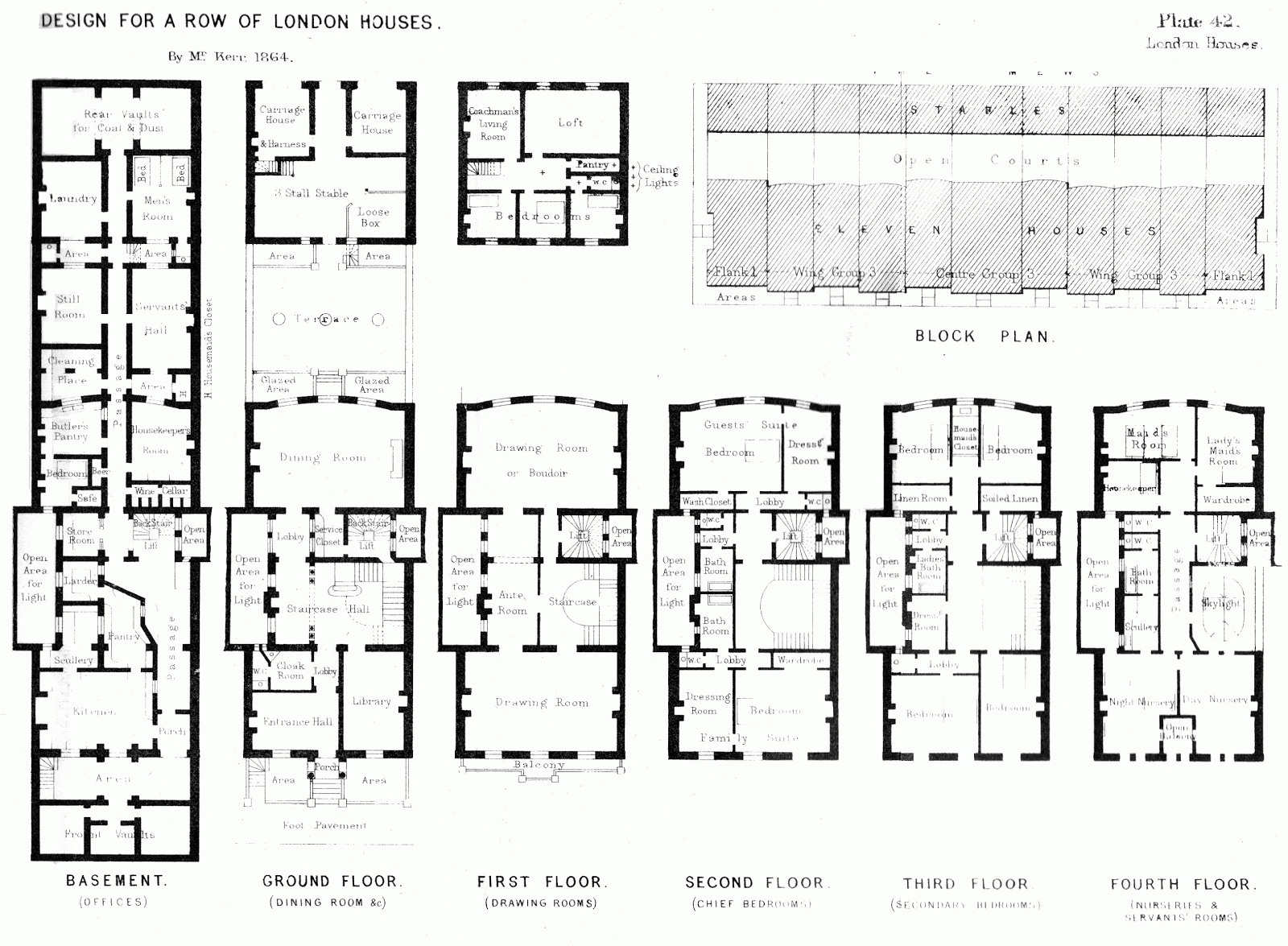|
| | Author | Message |
|---|
nordmann
Nobiles Barbariæ

Posts : 7223
Join date : 2011-12-25
 |  Subject: Architectural plans ... Subject: Architectural plans ...  Tue 13 May 2014, 10:19 Tue 13 May 2014, 10:19 | |
| ... can reveal so much, or so the thought struck me when I came across this 1860s plan of a proposed Belgravian home which after a little snooping around on the internet appears to suggest the terraced buildings that were built on the north side of Eaton Square. What jumped out at me was that despite the impressive size of the residence (remembering this is after all a terraced dwelling intended for middle class customers) the space allocated and intended solely for the use of the owner and possibly their spouse was so huge when compared to everyone else who would live there. With servants and children consigned to the attic, and all drudgery, including cooking, consigned to the basement the remaining 80% of space is totally given over to the couple and their possible guests' dining, withdrawing, dressing, sleeping and anything else they alone wanted to get up to. This in itself graphically represents the contemporary concept of what constituted "family life" in its day.  If my guess regarding specific location is correct then the third house from the left on the "Block Plan" above is now the Bolivian Consulate. PS: the stables indicated on the block plan would now be the mostly two-bedroom houses on Eccleston Mews which sell on average according to London's most recent Zed-Index estimates at £1,951,193 each. |
|   | | ferval
Censura

Posts : 2602
Join date : 2011-12-27
 |  Subject: Re: Architectural plans ... Subject: Re: Architectural plans ...  Tue 13 May 2014, 10:46 Tue 13 May 2014, 10:46 | |
| Heavens, the servants must have had remarkably good bladder control, it appears that their only toilet facilities are on the fourth floor.
The house where I live now was built at around the same time and is a lower middle class version of those terraces - only three floors but a very similar layout. I inhabit the basement, the old kitchen/servants' quarters, but, happily, these were built where there was less pressure on land so rather than being below ground level, there's a sloping garden to the front and a largish, south facing garden to the rear at my level so I'm not in perpetual gloom and the whole area is much leafier and greener than in the city centre. We still have the original cobbled lanes between the terraces and many of the old brick walls; my granddaughter loves wandering these, just as I did at her age. The difference is, I could do so on my own, or with friends, whereas it's inconceivable to allow that now. |
|   | | nordmann
Nobiles Barbariæ

Posts : 7223
Join date : 2011-12-25
 |  Subject: Re: Architectural plans ... Subject: Re: Architectural plans ...  Tue 13 May 2014, 11:18 Tue 13 May 2014, 11:18 | |
| - ferval wrote:
- Heavens, the servants must have had remarkably good bladder control, it appears that their only toilet facilities are on the fourth floor.
A feature that was used as a plot device in one episode of "Upstairs Downstairs" if I recall correctly. The series of course featured a house on the same square in Belgravia but on the western "posh" side. Half the basement and the old first floor in one such des res recently sold for £4,500,000 - garden access sold separately.  |
|   | | ferval
Censura

Posts : 2602
Join date : 2011-12-27
 |  Subject: Re: Architectural plans ... Subject: Re: Architectural plans ...  Tue 13 May 2014, 11:54 Tue 13 May 2014, 11:54 | |
| This is the area, once memorably described in an article as *Glasgow's Nottinghill*. Fortunately I have never encountered Hugh Bloody Grant hanging about. A full terrace ( I live in one of the Squares) is around £500,000 these days. http://www.glasgow.gov.uk/CHttpHandler.ashx?id=6516&p=0 |
|   | | nordmann
Nobiles Barbariæ

Posts : 7223
Join date : 2011-12-25
 |  Subject: Re: Architectural plans ... Subject: Re: Architectural plans ...  Tue 13 May 2014, 12:10 Tue 13 May 2014, 12:10 | |
|  This beautifully bound volume of architectural plans is to be found in the British Museum - and for a very good reason. The plans were designed by Henry Flitcroft in 1725 as his vision for his employer the Duke of Montagu's London residence after some renovation and the painstaking detail with which he embellished his draftsmanship is impressive. Note the individually drawn roof-tiles on the outhouses on either side of the building's two wings. The reason it is apt that it should be viewed in the British Museum is of course that Montague House, as it was originally known, was to become in time the main British Museum building in Bloomsbury and lasted until the 1840s when it was demolished to make way for the building standing there now. This is at it appeared when built:  Ralph Montagu, the original owner, led what could only be described as a charmed existence. A survivor of the "Glorious Revolution" despite having in turn supported the Duke of Monmouth and then the Duke of York (each would have regarded the other allegiance as treasonable and both would be regarded as treasonable anyway by Dutch King Billy afterwards), and then having survived a particularly nasty political feud with Lord Danby, Duke of Leeds, which cost him most of his wealth and almost saw him flee to France to escape execution, he managed through two successive marriages to rich daughters of eminent gentry (it helped that one of these was the widow of Christoper Monck, 1st Duke of Albemarle) to become in time one of the richest men in England. When his son John married the Duke of Marlborough's daughter his family's acceptance into the kernel of English wealth and power was finally copper-tightly secured. John however thought Bloomsbury a little below his station (I kid you not!) and moved to Whitehall, allowing the eventual 1759 sale of the premises to the new Museum's trustees. Of course what replaced his old gaff was no hovel itself ...  Sorry ferval - crossed posts |
|   | | nordmann
Nobiles Barbariæ

Posts : 7223
Join date : 2011-12-25
 |  Subject: Re: Architectural plans ... Subject: Re: Architectural plans ...  Wed 14 May 2014, 09:32 Wed 14 May 2014, 09:32 | |
| Despite what one might have learnt from Asterix and Cleopatra, Egyptian and classical Greek architects did not work from plans drawn out on papyrus in the style of modern blueprints, at least for the monumental structures they left behind. The technique they used for buildings which might take several generations of workers to construct was eminently simple but no less technically impressive than any modern counterpart, and indeed it was a technique replicated down through the centuries and into the great age of Gothic cathedral construction. Amazingly however, even though the technique was well understood and documented regarding medieval cathedrals, as was the absolute logic in the original plans being presented so they could be found and followed by workers living long after the original architect's demise, it was a chance observation as recently as 1979 by Munich archaeologist Lothar Haselberger that proved its ancient pedigree. He was working in Didyma, the Oracle of Apollo near Miletus, when he spotted this on the inner sanctuary wall:  Fortunately for Lothar on this occasion he happened to be walking past the wall just as the setting sun's rays struck the surface at an angle that revealed in their shadow a complex series of lines (just about discernible in the picture above). After some time studying the patterns he realised he was looking at the architect's plans for the entire complex and we now know that the design pertains to the rebuild of the oracle complex ordered by Alexander the Great but initiated and largely completed within the reign of the first Seleucid Emperor in the region, Seleucis i Nicator. Since 1979, now that people know what they are looking for and how to read them, similar "blueprints" have been found etched into the walls of several structures from ancient times, even some in Egypt predating the Apollo temple by almost a thousand years. Incidentally, other archaeological sources revealed some of the prices paid for parts of the Apollo temple construction and recorded by Miletan book-keepers. Interestingly each column we know was priced at 40,000 drachma at 300BCE rates. Using a rudimentary currency conversion technique scaling prices up to modern times that means that each column cost just over a million US dollars. The temple contains 120 of them (three F-18 fighter planes' worth). The rest of the temple probably cost twice as much again. Worth thinking about. |
|   | | Gilgamesh of Uruk
Censura

Posts : 1560
Join date : 2011-12-27
 |  Subject: Re: Architectural plans ... Subject: Re: Architectural plans ...  Wed 14 May 2014, 11:35 Wed 14 May 2014, 11:35 | |
| In terms of bucks/annum, far better value than 3 F-18s. |
|   | | nordmann
Nobiles Barbariæ

Posts : 7223
Join date : 2011-12-25
 |  Subject: Re: Architectural plans ... Subject: Re: Architectural plans ...  Wed 14 May 2014, 13:22 Wed 14 May 2014, 13:22 | |
| I tend to agree - if one checks all the monumental building work undertaken by Seleucis i Nicator during his reign and base the presumed overall expenditure on what we know about the temple of Apollo then it shows a huge disparity between money spent on servicing the divine or intellectual aspirations of the people and that spent on the bellicose, a disparity favouring by far the former. We tend to think of Alexander's time as one completely given over to matters martial and that society existed and measured its success only in terms of serving the military ambitions of its rulers. The available evidence from Ionia and the Seleucids counters that misapprehension rather effectively. |
|   | | Sponsored content
 |  Subject: Re: Architectural plans ... Subject: Re: Architectural plans ...  | |
| |
|   | | |
Similar topics |  |
|
| | Permissions in this forum: | You cannot reply to topics in this forum
| |
| |
| |
